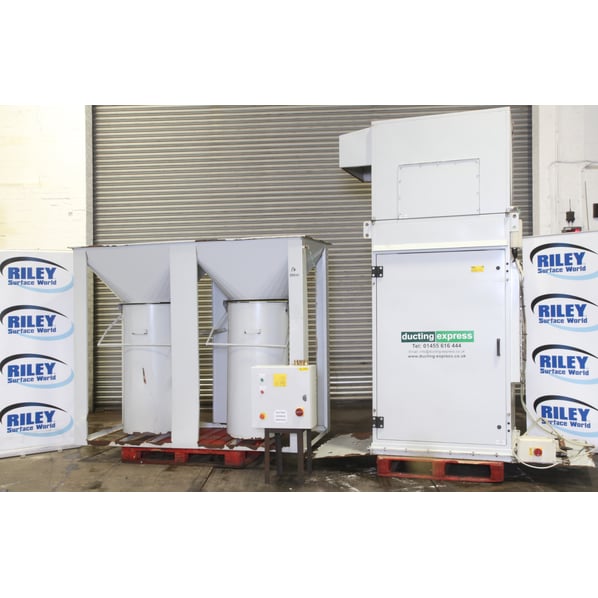Dust Extraction Int Ltd 11kW, ATEX Rated Dust Extractor

- Stock No
- ED2115
- Manufacturer
- Dust Extraction Int Ltd
- Model
- 40M
- Year of Manufacture
- 04-2015
- Serial
- 15122001
- Condition
- From a working environment, Good Condition
- Approx Duty CFM / M³/Hr
- 4000CFM // 6800M3/Hr
- Filter Area ft² / m²
- 400ft2 // 37M03.
- Other Info
- 720Litre Total Dust Capacity Collection
- Location
- Our Central Warehouse, Aldridge, UK
- Weight (kgs)
- 585
- External Dimensions (WxDxH mm) [?]
- 2320 x 1100 x 4750
- Delivery Your delivery options
Description
This second hand unit is powered by a 11 kW // 15 Hp fan covered by a silencer, ideally designed for outdoor location. There is an ATEX explosion relief panel. The waste materials are collected in the very large, twin quick release steel bins at the base of the machine.
A compact versatile dust collector, robust self-contained auto-shake and filter bags.
The 40M is particularly suitable for commercial applications because of its large capacity and simple operation.
Specifications
- Twin 360 Litres quick release dust collection bucket.
- 15 internal bag filters.
- ATEX rated explosion relief panel.
- 11 kW // 15 Hp fan motor.
- Rear inlet apertures (2 off) of 600 x 150mm
- Bag filter area 400ft² // 37M².
Possible Applications
- Foundry - fettling castings.
- Paper or general recycling.
- Ferrous and non-ferrous metal finishing.
- Manual processes such as grinding and linishing.
- Wood working workshops and manufacturing sites.
- Educational workshops.
- Working booths for ceramics and pottery.
Factors to Consider for Your Next Dust Extractor
When implementing the safety measures to ensure minimal risk to your workers, the factors to consider when purchasing your extraction unit/system are:
- Dust Source - Does the process that produces dust occur in an enclosed or open area?
- Capacity - Does the extractor have a large enough filter area required to handle the volume of dust?
- Type of Dust – Do you need an extractor capable of handling dust at risk of self-igniting?
- Maintenance – Would a self-cleaning extractor with an automatic shaker cycle be more suitable for you?
For further guidance, find out how to carry out your own COSHH (Control of Substances Hazardous to Health) risk assessment at the HSE website to help calculate your requirements.
What is Dry Dust Extraction?
The most popular dust extraction method, dry dust extractors collect dust using filters and cartridges. Known for processing large volumes of air when filtering medium/large dust particles such as wood, flour, and metals.
They typically include a cleaning system to discharge the dust gathered within the filters and cartridges, they carry out a shaker cycle or reverse pulse cycle to free the collected dust and empty it into a removable storage bin.
What are Shaker Dust Collectors?
Shaker Dust Collectors contain a number of woven bags, which are fixed onto rails and use their surface area to capture dust as it is drawn through the extraction unit by its fan.
Bags are periodically cleaned by rapidly shaking the bags through a shaker motor and linkage system which removes the filtered dust from the bags and into a collection bin.
These units are commonly used in foundries, steel mills, the mining industry, power plants, and smelting industries.
Importance of Explosion Panels in a Dust Extractor
As extraction systems suck in air in concentrated volumes, the risk of explosive dust igniting is greater; therefore precautions are required to control the risk. A dust extractor with explosion panels installed will have these panels located in the areas where the dust is most likely to combust, controlling the explosion so it ignites in the area that has been constructed to withstand the impact without damaging the extractor itself.
How do Dust Extractors Work?
Dust collection systems work in a variety of different ways but all have general principles in common. They draw process dust and particulates from the air through a filter that first captures and separates the matter, and then discharges decontaminated air back into the workplace or environment.
Dust extractors are used in many different and varied industries and so different demands are made of them; however all have common components such as a blower (or fan), dust filter, filter cleaning system, dust container and dust removal system.
Five common types of dust collection equipment are fabric filter baghouses, inertial separators (like mechanical cyclones), cartridge collectors, wet scrubbers, and electrostatic precipitators.
Importance of Dust Extractors
Dust in the workplace can affect product quality and employee´s health. Having a dust-free environment is essential to the health and safety of the workforce. Not only does it affect the health of employees but the dust covers the equipment affecting production processes and quality of the products.
Capturing the dust at the source prevents it from spreading, done by using a dust extractor system to facilitate the important housekeeping to avoid it from accumulating.
![]() Print / Download Dust Extraction Int Ltd 11kW, ATEX Rated Dust Extractor Datasheet
Print / Download Dust Extraction Int Ltd 11kW, ATEX Rated Dust Extractor Datasheet
Photographs taken prior refurbishment. Our refurbishment service is not available on all machines.
Machines & equipment for sale
- Surface Treatment
- Cleaning & Degreasing
- Polishing & Belt Linishing
- Mass Finishing
- Ovens & Furnaces
- Process Cooling
- Shot Blasting
- Dust & Fume Extraction
- Air Compressors
- Rectifiers & Transformers
- Miscellaneous
- Latest Stock
- Special Offers
- Direct From Site Clearances
- Auctions
- Brand New Machines
- Available Immediately
- Sell Your Machine
Machine Alert
Get the latest machines emailed directly to you as they become available to buy online. Sign Up Now













